The Shifting Mystery
It’s always really disappointing when you build your bike and get it primed for the road, clean and freshly greased, only to find on your first test run that it’s unrideable. When you change up a gear for the first time, and.. crunch..the gears slip and grind, leaving you weaving on the road looking down at your derailleur and feeling rather stupid. My gold “Peugeot”, which you may have seen before in an earlier blog, ( though I’m more convinced now it is actually not a Peugeot ), has been giving me this headache recently. As is common with gear issues, it shifts fine on the stand, but once body weight and real pressure is applied to the pedals the gear slipping can start.
Solving the Gear Issue: The Chain
The chain is always top of my list when I look for gear slipping issues. So many older bikes have worn chains, making them the cause of the shifting problems. A worn chain will simply not grab onto the freewheel teeth as well as a newer one. However, in this case, the chain I have on the bike is new. Be that as it may, there is another possible problem with the new chain: is it too narrow? I measured the width of this chain with a digital caliper, though this is not entirely accurate. This chain ( which fits a 6/7/8 speed ) is 7.3mm wide. In contrast, I measured a vintage chain of a 10 speed Mercier, and it measured 8.10mm, which is nearly a one millimetre difference in width. This may not be the cause of my shifting problem, but I believe the narrower chain requires more precision when the chain jumps from cog to cog, exacerbating any problems in the shifting process that may already exist. Simply put, a wider chain will mesh more easily with a freewheel cog.
The Freewheel
Freewheels don’t last forever, even though they are made of very hard metal. Years of meshing with chains, that are most often dirty and pick up grit from the road, eventually wear down the freewheel teeth. Freewheels are one of the prime suspects in the case of slipping gears. Looking closely at my Maillard 6 speed, the teeth look pretty good and are certainly not rounded down like some old freewheels I’ve seen over the years. Unfortunately, there’s no easy way to test freewheels, I suppose you just have to try another wheel and see if another freewheel does better. However, a lot of this problem-solving with gear issues is instinctive, and I don’t think this freewheel is the problem just by looking at its condition. Perhaps, however, being a 6 speed does makes it just a little less tolerant with any inaccuracies than a 5 speed on this hub.
The Cable: Distance and Travel
It has to be up there as enemy number one when it comes to clunking gears. Cables are a crucial factor in making the the whole derailleur system function properly. I mean, we are talking millimetres here, when pulling and pushing the gear lever on the downtube. An old cable must be replaced. The levers should be checked for any slacking under pressure, as this can occur when the butterfly nuts are too loose. The lever, however imperceptively, moves back under tension and slackens the cable. You could call this the invisible hand of gear shifting. Also, you have to look at the travel of the gear lever. On my Peugeot, it is going too far for my liking, all the way to a flat position, which is nearly as far as it can go. This greater travel means more cable application, which in turn means more movement and more likelihood for slacking and imprecision. I also didn’t forget to check the housing for any clogging or kinks or friction, but also to look at how smooth the flow of the cable is through the housing; housing should always have some slack and aid the flow of the cable.
Chainline
Chainline is a crucial element of how your gear setup works. With vintage bikes, I find that often when you change a wheelset, especially upgrading to a freewheel with more cogs, chainline can become an issue. Why? Well, the hub spacing may very well be different with the new wheel, and you may also find that the first cog may sit too close to the chain stay or the largest cog may not be reached without chain rub. All these problems are symptoms of a new, perhaps even just a slight, variation in the chainline, which can cause chain rub on the large ring of the crank, front derailleur alignment problems, and just a general malaise of gearing as the whole gear system has now changed by a series of small measures. Chainline can be checked by looking along the chain from the back of the bike, from the freewheel to the crankset. My Peugeot isn’t as straight as I’d like it to be, but is it the problem?
The Rear Derailleur
Some vintage rear derailleurs are just better than others at coping with different gear ratios. The shifting problem with my Peugeot is unlikely to be my Simplex SX 610. My largest freewheel cog is well under the 34 teeth that this derailleur was designed to handle. The chain gap, the distance between the last tooth of the freewheel and the first tooth of the derailleur jockey wheel, is very small, which is a good thing. The gap stays small and there’s no coming together of derailleur and freewheel. If this was a Campanolo Nuovo Record, however, I’d have serious doubts that of its ability to handle a 6 speed freewheel, and that’s from direct experience of owning one for a while. So I don’t see the Simplex as the culprit.
An Unsolved Mystery?
After going through each possible source of the problem, there wasn’t one simple fix for the shifting issues of the this bike. Sometimes it seems a custom setup with a vintage bike, in which you choose your own parts and set the bike up yourself, can cause some mechanical complications and mysteries. The gear cable was a bit slack, and this helped the gear changing a little. I also lubricated the derailleur and chain again, which also helped a little. At this time, with more precision on the lever and learning how much to shift for each gear change, the transmission is passable. It is not what I’d like it to be, but perhaps it is as good as it will be on this 6 speed setup. The mystery may never be solved, but that’s something I can live with.


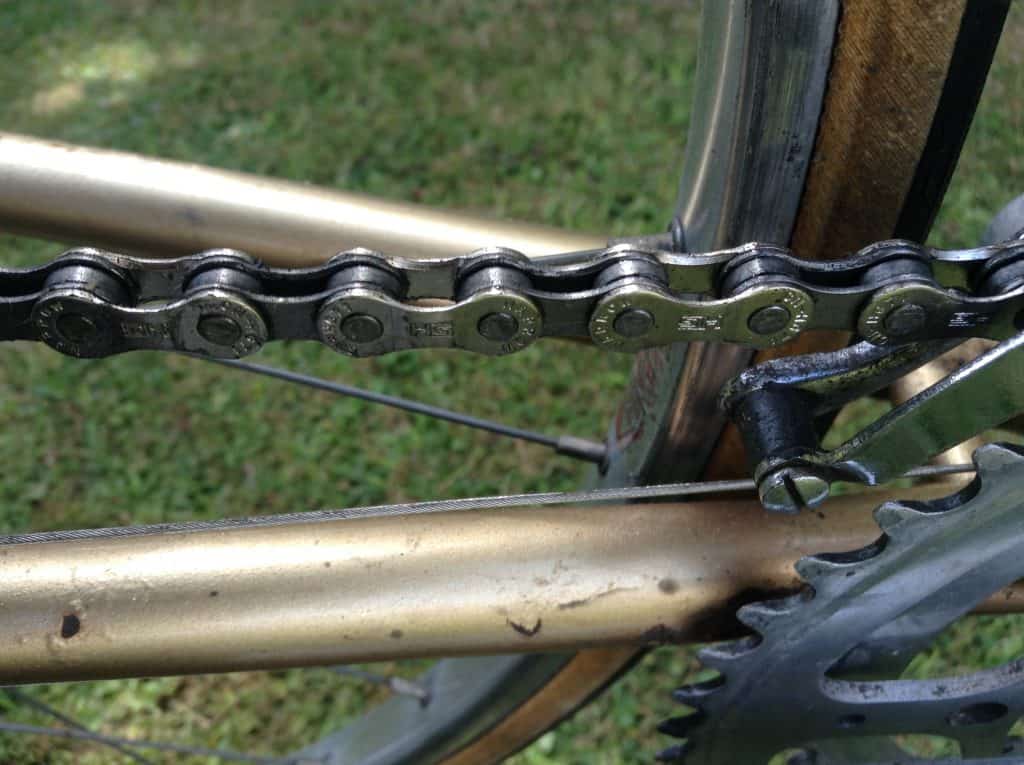
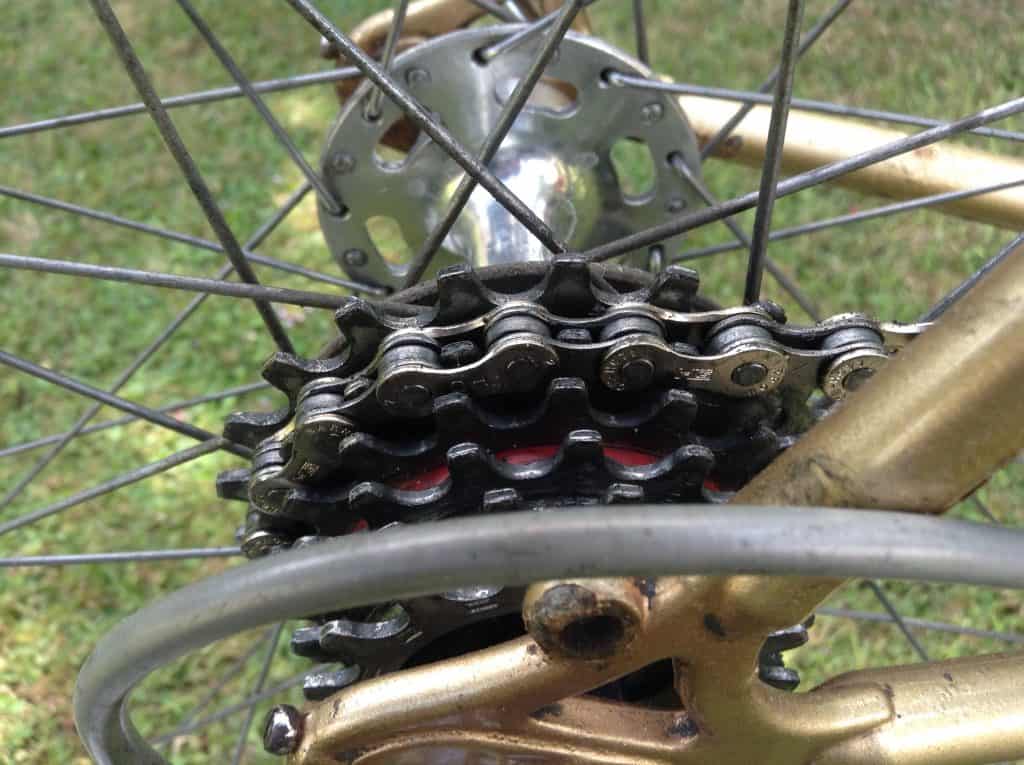
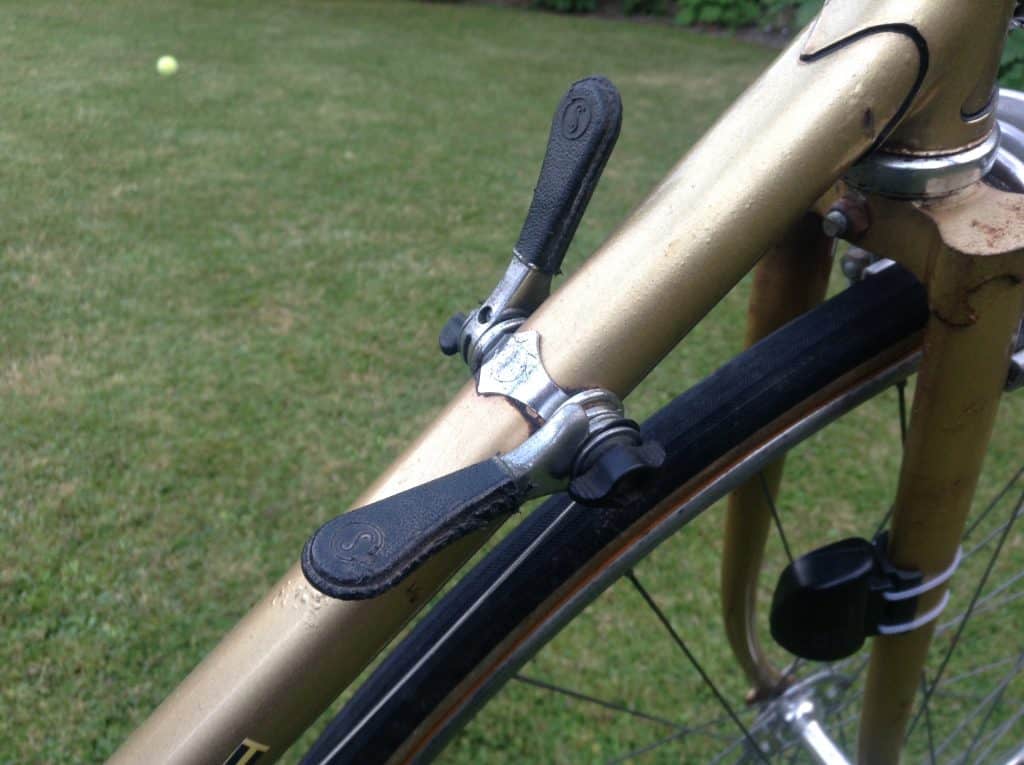
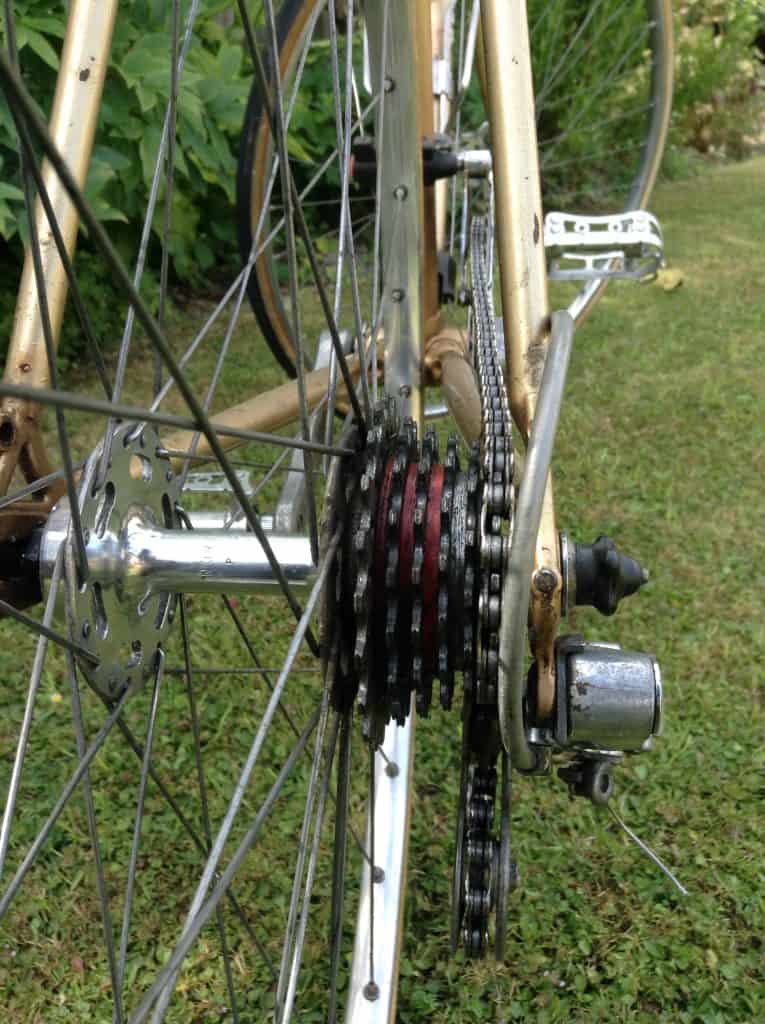
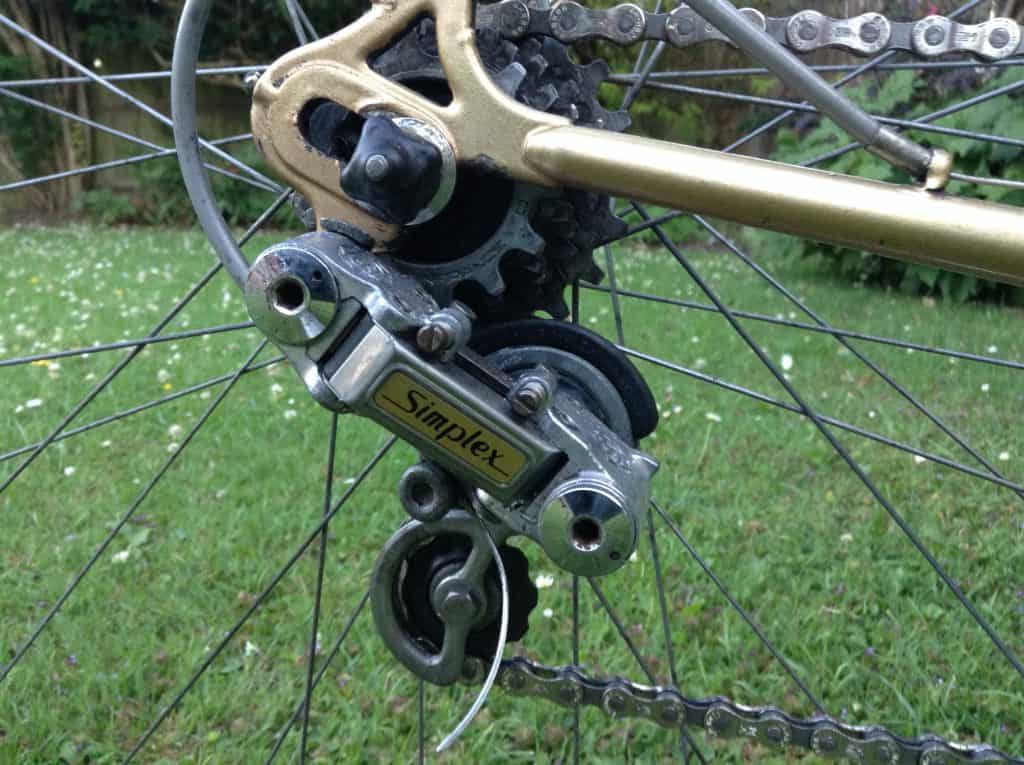
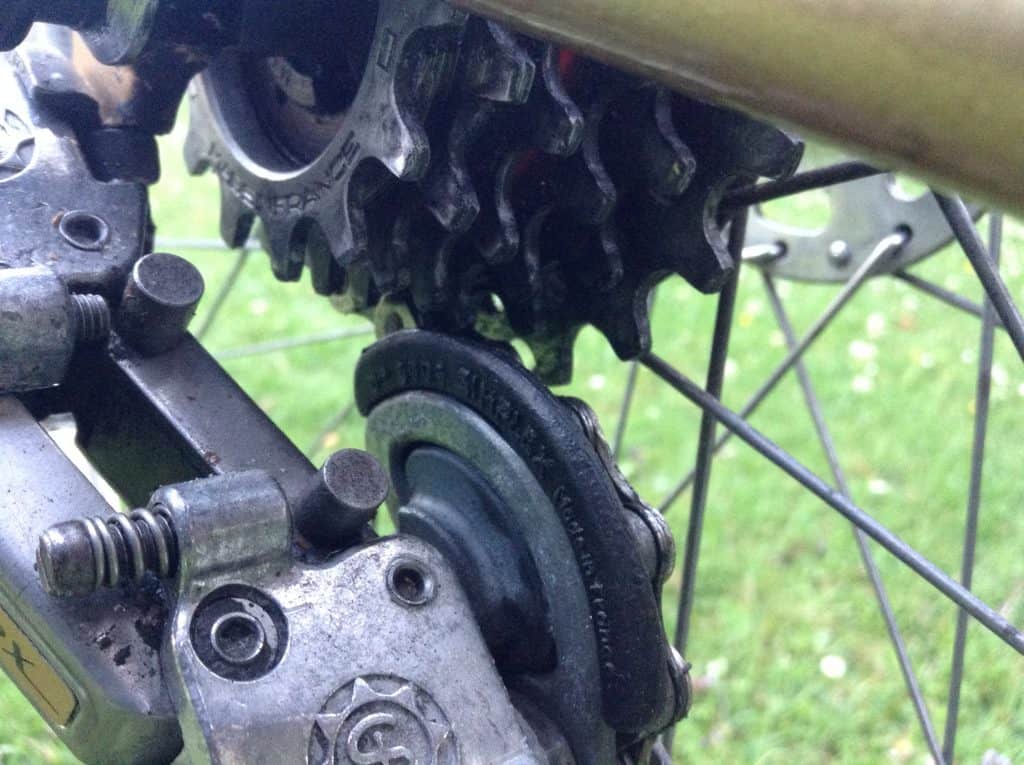
I restored this same gold bike this fall and still can not find which Peugeot model it is? The crank is sweeeeeet. Please let me know.
Hi John, I think yours sounds like a PFN10. This bike turned out to be another marque, possibly France-Loire, but rebranded as a Peugeot.
Is your rear derailleur hanger bent? It kind of looks that way in the picture.